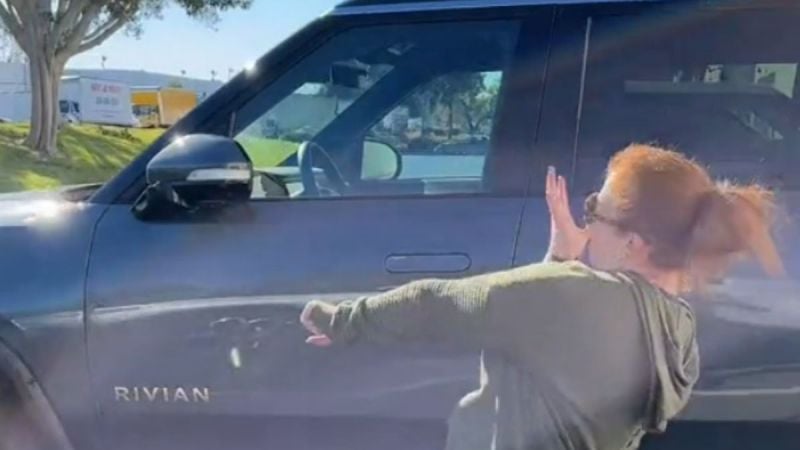It's frustrating standing next to your vehicle and just waiting for it to unlock when you expect a seamless entry instead. This is especially true when we’re talking about high-end electric vehicles like the Rivian R1T and R1S. But as more owners begin to speak up, it’s clear that not everyone is enjoying that kind of luxury. That’s what I saw when I came across a post from Regan Yu that caught my attention. Regan explained how both her first-generation R1T and second-generation R1S consistently struggle with the Phone Key App. Despite using the same phone that worked flawlessly with her previous Tesla Model Y, the Rivians routinely fail to recognize her device.
Here's her describing the situation: “This is my 2nd Rivian, and both have had issues with the 'Phone Key App'. In both my 1st Gen R1T and my 2nd Gen R1S, I'm having to do the dance at least 50% of the time. Is there a trick to have the vehicle recognize my phone and unlock the car without having to wait, for what sometimes feels like forever, for the phone to unlock the vehicle? Sometimes I have to open the app and unlock it from there and even then that doesn't always work so well. This is one area Tesla just gets right 99% of the time. I have an Android Pixel 6, and never had an issue with my Model Y on the same phone.”

What Other Owners Are Saying
Regan’s not the only one dealing with this. It touches on a broader trend of Rivian owners grappling with software quirks, many of which feel out of place for a company pushing the envelope on electric adventure vehicles. The phone-as-a-key feature, once viewed as a convenience, can quickly turn into a point of friction when it doesn’t work as expected. And when you’re paying north of $70,000 for a vehicle, that friction starts to wear thin. Especially if you’ve already dealt with unexpected ownership frustrations like strange startup noises.
Others did try to help though, and Vincent Fleming offered his take on a quick fix in the comments: “You have to always allow the app to run in the background. Simple fix.” He’s not wrong that modern Bluetooth-based digital keys rely heavily on uninterrupted communication between the phone and the vehicle. But even this “simple fix” doesn’t work for everyone, especially when Rivian’s system behaves inconsistently across phone models and app versions.
Amy Heckman chimed in with a sentiment that perfectly captures the love-hate relationship many Rivian owners seem to have: “I have the same problem! It makes me crazy but I love my R1S!” That blend of affection and frustration isn’t uncommon, and it seems to be a recurring theme among early adopters.
Then there’s Alex Camargo, who raised a good point: “How old is your phone? I had an S22 and it was super annoying. With my S25 now, it's opening from the far end of my house.” For some users, a hardware upgrade makes a world of difference, but this highlights just how sensitive these systems can be to phone model and Bluetooth signal strength. But even so, should a user have to upgrade their phone just to consistently unlock their car?
When the Hardware Fails Too
Chris Lee added another dimension to the issue, suggesting that it may not be just the software or the phone at fault. “Might be worth opening a service ticket. I was having similar issues and learned that there's something like 5 different sensors in the truck to sense your phone or key and try to determine which seat you're in, so it knows which profile to load for the driver. They ended up replacing a few of mine and it's much much better now.”
This brings attention to a deeper issue of sensor redundancy and hardware-level bugs. It's a good reminder that the problem isn’t always user-side. Faulty proximity sensors or Bluetooth modules can wreak havoc on an otherwise elegant user experience. It’s similar to what another Rivian owner experienced when both their primary vehicle and the loaner failed, reinforcing that not all issues are isolated to software alone.
The Tesla Comparison Is Inevitable
And while Rivian’s growing pains are understandable given their newcomer status, it doesn’t stop owners from comparing their experiences to more mature brands. Regan, like many others, highlights Tesla’s smooth execution of phone key functionality. The irony is that Tesla also had its own rocky start with digital keys, but they’ve since evolved to the point where many owners consider it seamless. In contrast, some Rivian users spent months blaming the vehicle before discovering it was actually a settings issue on their own device.
It’s easy to see how this issue contributes to broader concerns around ownership satisfaction. Rivian clearly has the appeal, the styling, and the innovation. That’s what drew in many former loyalists from legacy brands, including those who left Lexus behind after seeing Rivian’s vision. But execution on the small things still needs a touch of refinement.
There are still going to be stories of things going completely sideways, and reliability hiccups, big or small, can influence how owners perceive the brand’s maturity and readiness for mass adoption.
I think this is a perfect example of how software-defined vehicles are reshaping what ownership really means. The reliability in the smallest of interactions matters more as time goes on. And when those small yet essential interactions don't work like they should, they chip away at the confidence you’re supposed to have in a premium, tech-forward brand like Rivian.
Key Takeaways
- Phone-as-key systems live or die by the quality of their software integration, hardware sensors, and phone compatibility. No one wants to be left outside their $90,000 truck.
- When something feels off with your Rivian, it might not just be a glitch—hardware faults and sensor issues are real possibilities. Don’t hesitate to get it checked.
- Compared to Tesla, Rivian still has a ways to go in making digital access seamless, but feedback from owners like Regan is exactly what helps push things forward.
- Sometimes the problem isn’t Rivian at all, it could be your phone settings, background app restrictions, or outdated hardware. But the fact that it’s hard to tell shows the experience still needs streamlining.
Join The Conversation
Have you had any trouble using your phone as a key with your EV? If you’ve owned both Rivian and Tesla, how do their digital access systems compare in real-world use?
Aram Krajekian is a young automotive journalist bringing a fresh perspective to his coverage of the evolving automotive landscape. Follow Aram on X and LinkedIn for daily news coverage about cars.
Image Sources: The "RIVIAN Electric Vehicles Discussion" public Facebook group and Rivian's Gallery, respectively.











